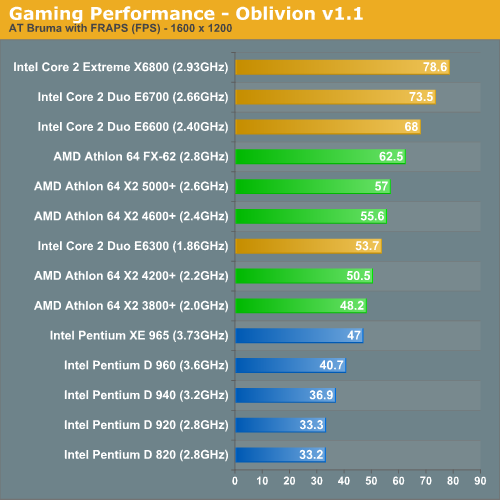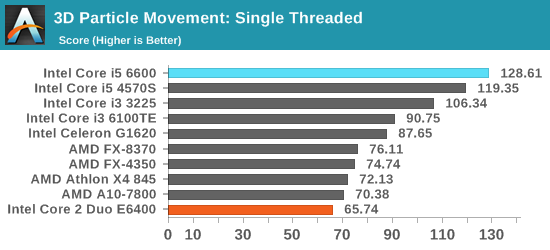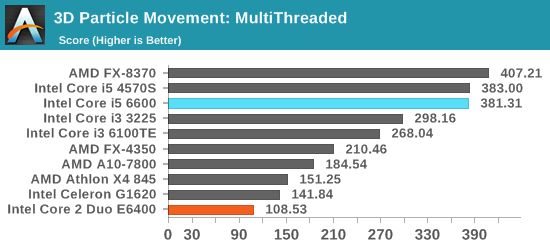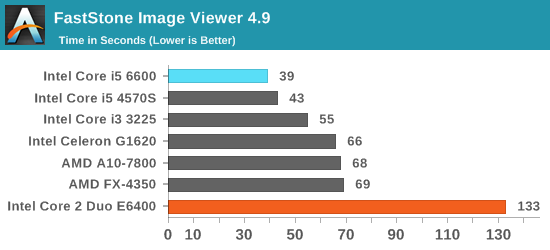Ten Year Anniversary of Core 2 Duo and Conroe: Moore’s Law is Dead, Long Live Moore’s Law
by Ian Cutress on July 27, 2016 10:30 AM EST- Posted in
- CPUs
- Intel
- Core 2 Duo
- Conroe
- ITRS
- Nostalgia
- Time To Upgrade
Core: Performance vs. Today
Looking back at Anand’s original review, and at a time where CPU performance made a lot of difference for gaming frame rates at 1600x1200, the conclusion was quite startling.
Intel's Core 2 Extreme X6800 didn't lose a single benchmark in our comparison; not a single one. In many cases, the $183 Core 2 Duo E6300 actually outperformed Intel's previous champ: the Pentium Extreme Edition 965. In one day, Intel has made its entire Pentium D lineup of processors obsolete.

Imagine something like that happening today. (Actually, if you believe what we’ve been told, AMD’s upcoming AM4 platform with Zen and Bristol Ridge might make its current desktop platform obsolete, but that’s a slightly different discussion because of how integrated graphics has adjusted the landscape for CPU focused silicon somewhat.)
That’s Intel vs. Intel though, against AMD it was just as damning.
Compared to AMD's Athlon 64 X2 the situation gets a lot more competitive, but AMD still doesn't stand a chance. The Core 2 Extreme X6800, Core 2 Duo E6700 and E6600 were pretty consistently in the top 3 or 4 spots in each benchmark, with the E6600 offering better performance than AMD's FX-62 flagship in the vast majority of benchmarks.
However, Core 2 Duo has now been out for 10 years. I’ve pulled up some benchmark data from our database to see if we have any matches to compare against processors that cost $214 today. The Core i5-6600 fits our bill perfectly, and there are two benchmarks which match up. I’ve also dotted the graphs with a range of more recent AMD and Intel processors for progression.



Our 3D Particle Movement is more for idealized synthetic workloads, however FastStone is all about image conversion and favors high frequency, high single threaded performance.
Naturally, modern processors nearing 4.00 GHz have a large advantage over the 2.13 GHz version of Core 2 Duo, as well as multiple generations of improved microarchitecture designs and smaller lithography nodes for power efficiency. However, has any processor family had as much nostalgic longevity as the consumer launch of Core? One could argue that while Core put Intel on top of the heap again, Sandy Bridge was a more important shift in design and as a result, many users went from Conroe to Sandy Bridge and have stayed there.










158 Comments
View All Comments
pixelstuff - Wednesday, July 27, 2016 - link
I think Core2 essentially accelerated the market saturation we are seeing and causing the PC market to decline a bit. My Core2 E8400 still runs Window 10 relatively fine, although I have built two more since because I like being near the cutting edge. However I know quite a few people still using Core2 CPUs for their basic computing needs.There just haven't been any new apps that are more resource intensive than a word processor or web browser which the entire world needs. So the PC replacement market has stagnated a bit.
stardude82 - Wednesday, July 27, 2016 - link
Most Core processors are faster than the ho-hum Cherry Trail offerings you find low end PCs. So buying a new cute shiny black little box to replace your beige big box doesn't guarantee much.boeush - Wednesday, July 27, 2016 - link
It reads a little weird/myopic that only certain technologies are being considered while forecasting all the way out to 2030. For instance, lots of NAND/DRAM discussion but no mention of upcoming or already early-adoption tech like 3D XPoint or memristors, etc. No mention of optoelectronics (like photonic signalling on- and off-chip), no mention of III-V and other 'exotic' materials for chip manufacturing and improved frequency/power scaling (with focus instead devoted to feature sizes/stacking/platter size/defects.) And so on.I mean, if you're forecasting 5 years ahead, I'd understand. But talking about 15 years into the future but only extrapolating from what's on the market right now -- as opposed to what's in the labs and on drawing boards -- seems to be a little too pessimistic and/or myopic.
Ian Cutress - Wednesday, July 27, 2016 - link
The full report mentions III-V and SiGe in the remit of future technologies. Anton and I are starting to discuss what parts we can pull out for individual news stories, to stay tuned.Sam Snead - Wednesday, July 27, 2016 - link
Heck I still have my Nexgen P110 cpu computer set up and run it once in awhile. From 1996. Remember the VESA local bus video card? Nexgen was later bought by AMD.stardude82 - Wednesday, July 27, 2016 - link
Ah, I remember Socket 7...CoreLogicCom - Wednesday, July 27, 2016 - link
I've still got a Dell E1705 laptop that I bought in 2006 which came with a Core Duo, which I upgraded to Core 2 Duo about 4 years into it, and maxed the RAM to 4GB (from the 2GB max it came with). It was decent, but really came alive when I put an SSD into it. I still use this laptop for basic stuff, and even some gaming (WoW and SWToR) with the Geforce Go GPU. It's definitely long in the tooth now, now running Windows 7 (it came with WinXP, but 10 is unsupported on the GPU even though there's a work around). I'm thinking mobile Kaby Lake and mobile Pascal will be the next laptop I keep for another 10 years.Nacho - Wednesday, July 27, 2016 - link
Can you beat me?Last month I finally upgraded my primary rig from a C2D E4300 @2.7Ghz! Memory started failing last year & I couldn't find cheap DDR2, so I was down to 2GB.
Went for a i5 6500 and 16GB DDR4. The difference is incredible!
Filiprino - Wednesday, July 27, 2016 - link
So much time since reading Anand's article on Conroe.3ogdy - Wednesday, July 27, 2016 - link
Great article, Ian! I've found it a very good read and it's always nice to take a look back and analyze what we've been through so far.I also wanna point out just a few mini-errors I've found in the article:
The Core 2 processors all came from a 143mm2 die, compared TO the 162mm2 of Pentium D. /
by comparison to the large die sizes we see IN 2016 for things like the P100 /
whereas the popular Core 2 Duo E6400 at $224 WAS at the same price as the Core i5-6600.
As we NOW know, on-die IMCs are the big thing.
Geometrical Scaling when this could NO longer operate
By 2020-25 device features will be REDUCED (?)
On the later -> LATTER?
Keep up the amazing work!